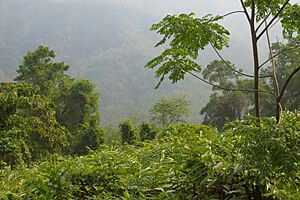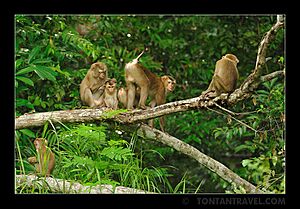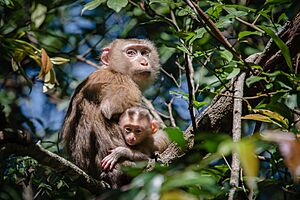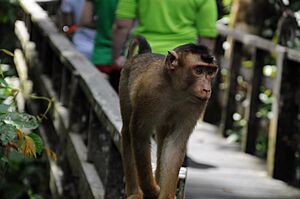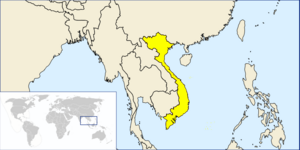Northern pig-tailed macaque facts for kids
Quick facts for kids Northern pig-tailed macaque |
|
|---|---|
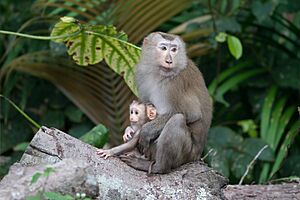 |
|
| M. leonina female with baby in Khao Yai National Park, Thailand | |
| Conservation status | |
| Scientific classification | |
| Genus: |
Macaca
|
| Species: |
leonina
|
 |
|
| Northern pig-tailed macaque range | |
The northern pig-tailed macaque (Macaca leonina) is a type of macaque monkey. It is considered a vulnerable species, meaning its population is decreasing. You can find these macaques in countries like Bangladesh, Cambodia, China, India, Laos, Myanmar, Thailand, and Vietnam.
For a long time, scientists thought the northern pig-tailed macaque was just a subspecies of the southern pig-tailed macaque. But now, it is known as its own unique species. These macaques mostly eat fruit, but they can also eat other things like plants, insects, and small animals when fruit is hard to find. Their social groups are led by females.
Contents
What do Northern Pig-tailed Macaques Look Like?
Appearance
Northern pig-tailed macaques have some special features. They have greyish fur around their cheeks, chin, and the top of their head, forming a "crown." There's a brown patch in the middle of this crown. They also have white triangle shapes under this patch and above their eyes.
You might see a red stripe at the outer corner of each eye, pointing upwards. Their snout is long, but still shorter than that of southern pig-tailed macaques. Males often have a black stripe down their back, sometimes with a reddish color near the top.
Their tails are thin and dark, shorter and skinnier than those of southern pig-tailed macaques. Tails can be shaped differently, but often point straight back or at an angle. They also have thick, oval-shaped sitting pads on their backside, which cover their hip bones.
Differences Between Males and Females
Male and female northern pig-tailed macaques look different. This is called sexual dimorphism. The easiest way to tell them apart is by their weight. Males usually weigh over 8 kilograms (about 17.6 pounds), while females are under 6 kilograms (about 13.2 pounds).
Adult males have strong, muscular shoulders. Their tails are also longer than females' tails, and their fur has darker colors. Females are generally smaller in size.
Baby macaques, called newborns, are up to four weeks old. They usually drink only breast milk and stay very close to their mothers. Infants, who are five to eight weeks old, start eating solid foods. After nine weeks, they become more independent from their mothers.
Where do Northern Pig-tailed Macaques Live?
Northern pig-tailed macaques live in tropical forests across several Asian countries.
China
In southwestern China, these macaques live in tropical forests, especially broadleaved evergreen forests at higher elevations. They avoid areas like rubber plantations because these places have less food and make it harder for them to move around.
Even though their homes are changing, these macaques are good at adapting. They adjust their daily routines based on the environment and the season. For example, during dry seasons, their space might become smaller because there's less food and water.
India
In India, you can find northern pig-tailed macaques south of the Brahmaputra River, in the northeastern part of the country. Their range includes areas like Assam, Meghalaya, and other states.
While we don't know the exact number of these macaques worldwide, some places have counted them. For example, in the Keo Seima Wildlife Sanctuary in Cambodia, their population is growing and is almost 4,000.
Thailand
In Northeastern Thailand, human activities like cutting down forests have affected northern pig-tailed macaques. Their home ranges can be very different in size, from 62 to 828 hectares. They can live at different elevations as long as there's enough tree cover.
In the Sakaerat Biosphere Reserve, a forest area changed over time. It became smaller, with parts turning into eucalyptus farms, regular farms, roads, and human towns. This made scientists study how the macaques adapted. They found that macaques still preferred sleeping in trees with two layers of leaves for protection. However, they chose sleeping spots mostly based on how close they were to food. This also led to them forming larger social groups.
How do Northern Pig-tailed Macaques Live?
Diet and Group Strategies
Northern pig-tailed macaques are mostly frugivorous, meaning they love to eat fruit. They can eat hundreds of different fruit types, as well as flowers, leaves, and other plant parts. These make up more than half of their diet.
When fruit is scarce, like in colder seasons or when their habitat is damaged, they become more omnivorous. This means they eat a wider variety of foods. They might eat human foods like rice and bread, or natural foods like fungi, ants, spiders, grasshoppers, and even small lizards or squirrels.
These macaques are very adaptable. They change how their social groups are formed and how they find food depending on their environment. If food is spread out, their group sizes tend to get bigger. If they rely on human food, they might move around less.
In wild environments, they often form smaller groups and move around more. Their home range changes with the seasons, depending on how much fruit is available. When wild fruits are scarce, they might travel to human settlements to find food, even if it takes a lot of energy. They prefer fruits from farms when wild ones are hard to find.
Reproduction and Social Life
Like all macaque species, northern pig-tailed macaques live in matriarchal groups. This means females are in charge. A female macaque is pregnant for more than eight months, usually with one baby. After the baby is born, the mother feeds it milk for up to two years.
What Threats do Northern Pig-tailed Macaques Face?
Viruses
Viruses are a common threat to northern pig-tailed macaques, especially in areas where their habitat is damaged. Scientists have studied how certain viruses, like types of human immunodeficiency virus (HIV) and simian immunodeficiency virus (SIV), affect them.
Research shows that the macaques' immune system can fight off some viruses better than others. For example, their bodies are good at preventing HIV from causing long-term illness. However, other viruses like SIV need to be watched closely. Northern pig-tailed macaques have also been affected by coronavirus 2, which can be deadly and spread easily among them.
Human Activities
The northern pig-tailed macaque is considered vulnerable because human activities are causing its population to shrink. These activities include:
- Expanding farms and fish farms
- Building roads and other transportation
- Hunting and logging for meat and trophies
- The illegal pet trade
These actions lead to macaques losing their homes and their forests becoming broken into smaller pieces. This makes it harder for them to find food, especially their natural diet of fruit.
The Pet Trade
The illegal pet trade is a big problem for macaques, especially in Vietnam. Between 2015 and 2019, hundreds of primates were taken from the wild for the pet trade. Northern pig-tailed macaques were among the most affected.
Many people don't realize how harmful it is to keep these wild animals as pets. Macaques kept as pets often suffer from being separated from their mothers and being alone. This can cause them to be afraid of new things, act strangely, or become sad and withdrawn. It can also affect their health.
Northern pig-tailed macaques were found in many places as pets, from private homes to hotels. While more people and authorities are becoming aware of this issue, rescue centers are often full. This means many macaques are released without proper checks for diseases or protection. Experts suggest collecting more information about macaques in Vietnam to help stop the pet trade and protect these animals.
Images for kids






